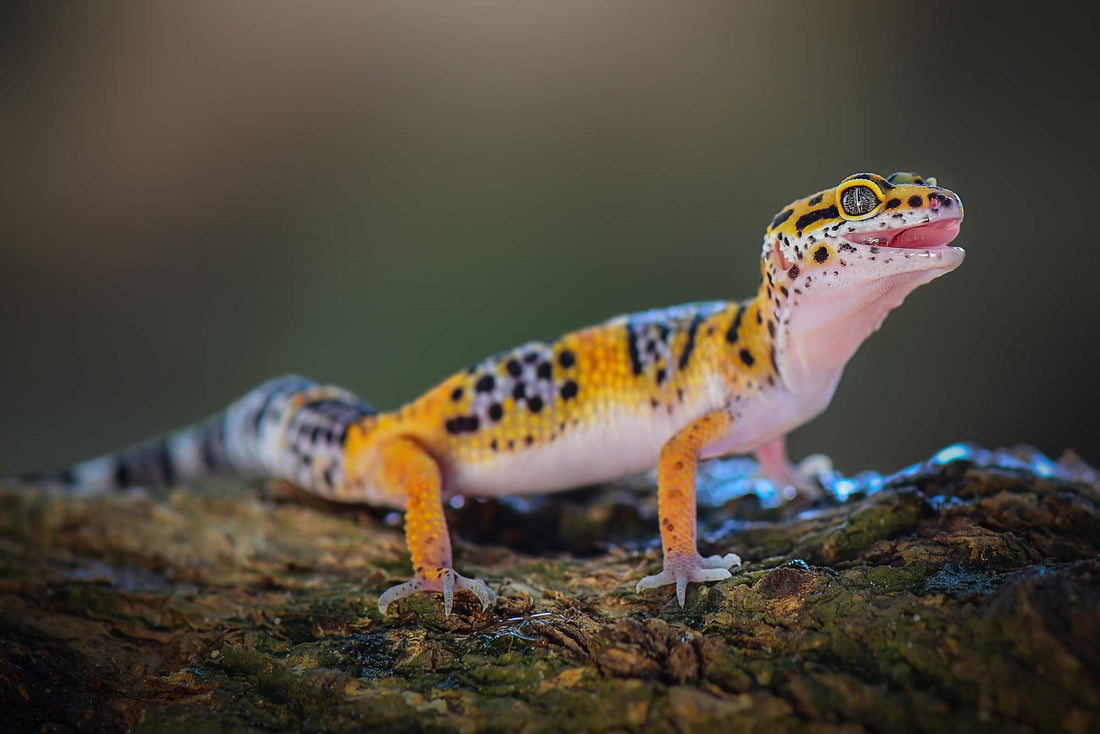Natural Habitat
Arid, rocky, semi-desert regions of the Middle East such as Afghanistan and Iran.
Leap Habitat Size
22”x17”x18”
Nutrition
Leopard geckos are primarily insectivores, meaning they mostly eat insects. Feeding your leopard gecko as wide a variety of insect prey as possible is best. Suitable feeder insects include: crickets, mealworms, superworms, dubia roaches, and silkworms. Your feeder insects should be fed with a high quality calcium rich diet to “gutload” them and make them more nutritious for your pet gecko. Feeder insects should also be dusted with a pure calcium supplement at almost every feeding. The feeders should also be dusted with a multivitamin supplement twice a month. Try to feed your gecko when it is active so it receives the benefits of the supplement powder before the insects remove the powder from themselves. Juvenile leopard geckos can be fed every other day and adults two or three times a week. The number of insects will vary greatly depending on the type of insect and the age of your gecko.
Five Parameters
-
Daylight/photoperiod
Leopard geckos are not strictly nocturnal but rather crepuscular, active at dawn and dusk. They experience seasonal variation in lighting in their natural habitat and that should be replicated in your home. We recommend that your Leap LED lighting is on for 14 hours a day in the summer, 12 hours a day in the spring and fall, and 10 hours a day in the winter.
-
UV/photoperiod
The necessary duration of UV lighting is still being researched and UV certainly isn’t at peak levels throughout the day. However, because leopard geckos spend much of the day hidden and under cover, we recommend that the UV light is left on for the same duration as your LED daylight. This will allow your leopard gecko to go in and out of its hide to expose itself to UV light when it feels the need.
-
Heat
In general a “hot” side of the habitat should be provided and reach temperatures of 90-95 F. The middle of the habitat can be in the low 80s or high 70s and the “cool” side should be in the low to mid 70s. Ideally your habitat should have two hides, or retreats, that your gecko can enter fully on either side of the habitat. One on the “hot” side and one on the “cool” side. Heat is best provided with a halogen bulb as this is our best current technology at replicating the natural heating benefits of the sun. We recommend that your heat bulb should be on for two less hours a day than your daylight and UV lights. For example, in the summer if your daylight photoperiod is from 6:00 am to 8:00 pm, your heat light should be on from 7:00 am to 7:00 pm.
-
Water/Misting
A common husbandry mistake when keeping desert reptiles, like leopard geckos, is the belief that they do not require water. Fresh water in a clean bowl should be provided for your leopard gecko at all times. It is also natural for desert animals to experience a morning dew. A brief misting right before the lighting comes on two times a week is beneficial.
-
Humidity/Fogging
Leopard geckos are desert animals and humidity should be low (30-50%) for most of the day. However, an increase in humidity at dawn is natural and beneficial. A brief, less than one minute, fogging session can provide this. Monitor humidity levels so that you do not overly saturate your gecko's habitat. All traces of moisture should evaporate by midday. Your leopard geckos hide on the cool side of the habitat should be kept slightly damp and humid, not saturated. This will aid with shedding.
Handleability/Pet metric
Leopard geckos are some of the best “pet” reptiles you can have! Juveniles are often flighty and wary of human interaction but adults are often extremely calm and handleable. In the beginning keep handling sessions brief and calm. Do not forcibly restrain your gecko. Allow it to climb onto your hand and then place one hand in front of the other as it crawls. Keep your gecko close to a surface like a table or the floor in case it leaves your hands. You don’t want your gecko to fall far. Remember, even a foot off the ground is a considerable height to an eight inch gecko. When handling your gecko avoid touching or pinching the tail as your gecko may drop it’s tail as a defense mechanism. If this does happen, know that it is not life threatening and it will grow back. Any handling done by children should be supervised by an adult.
Difficulty
Beginner. Leopard geckos are some of the hardiest and easiest to keep of all reptiles. They make an excellent first reptile. They often live 15-20 years and are relatively low maintenance.

